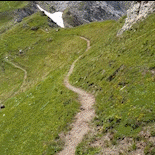When you travel from our country into the south to Italy e.g. you will have to cross the Alps. This part of a vacationvideo shows the way back to the north. Its a 3 minutes film.
The music is "Wiliam Tell" from Rossini.
The Alps (Alpi in Italian, Alpe in Slovene) is the name for one of the great mountain range systems of Europe, stretching from Austria, Italy and Slovenia in the east, through Italy, Switzerland, Liechtenstein and Germany to France in the west. The word "Alps" was taken via French from Latin Alpes (meaning "the Alps"), which may be influenced by the Latin words albus (white) or altus (high), or a Celtic word.
The highest mountain in the Alps is Mont Blanc at 4810 m on the French-Italian border



















